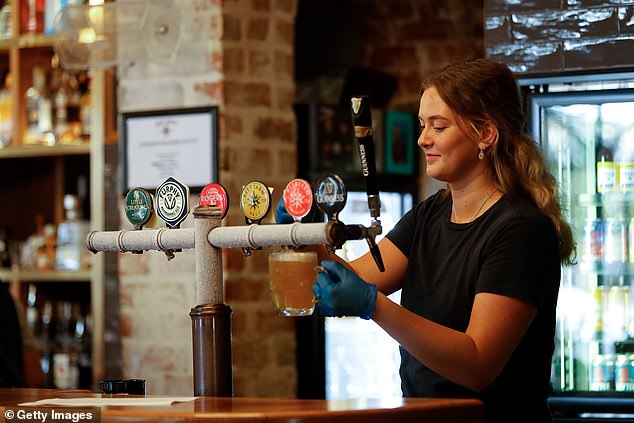- December quarter wages growth weakest in three years
Australian wages growth has fallen to the lowest level in almost three years – undermining Labor’s campaign promise to ‘get wages moving again’.
The wage price index in the December quarter grew by 3.2 per cent – the weakest annual increase since September 2022.
The three-month measure showed wages edging up by just 0.7 per cent, marking the slowest quarterly growth since March 2022 before Labor came to power.
Anthony Albanese campaigned during the last election to ‘get wages moving again’ with Labor accusing Scott Morrison’s former Coalition government of ‘deliberately holding back wages’.
The Prime Minister was even boasting about wages rising under his government, shortly before the Australian Bureau of Statistics data was released on Wednesday morning.
‘When we came to office, wages were in decline, inflation was on the way up, interest rates had started to rise,’ he told reporters in Sydney.
‘Now we see wages rising, inflation falling, interest rates falling and employment being maintained while tax cuts have been delivered. Happy to take questions.’
The 3.2 per cent increase in wages last year was higher than the headline inflation rate of 2.4 per cent, which meant workers had a real wage increase of 0.8 per cent.

Australian wages growth has fallen to the lowest level in almost three years – undermining Labor’s campaign promise to ‘get wages moving again’ (pictured is a Bunbury bartender)
But without the federal government’s $300 electricity rebates, underlying inflation was higher at 3.2 per cent, or above the Reserve Bank’s 2 to 3 per cent target.
The Reserve Bank released new forecasts on Tuesday predicting inflation was likely to soar back to 3.7 per cent by the end of 2025.
Should wages growth fail to pick up again in a slow economy, workers would go back to suffering a cut in real wages where their pay lagged behind inflation.
Labor since coming to power has introduced a series of new industrial laws designed to boost wages growth, from multi-employer bargaining to same job, same pay rules requiring labour hire workers to be paid the same as permanent employees.
Employment and Workplace Relations Minister Murray Watt last month boasted that wages growth was stronger under Labor.
‘Labor said we would get wages moving and that’s exactly what we are doing,’ he said.
‘The changes we’ve made are common sense – if you’re doing the same job, you should be getting the same pay.’
In a bid to boost wages, Albanese government has also undone the enterprise bargaining arrangements introduced by Paul Keating’s Labor government in 1993 that stopped wage rises in one workplace being automatically replicated across an industry.

Prime Minister Anthony Albanese was even boasting about wages rising under his government, shortly before the Australian Bureau of Statistics data was released on Wednesday morning
But the changes have failed to have an effect with private sector wages growth last year of 3.3 per cent falling to the weakest level since June 2022.
Public sector wages have also fallen below 3 per cent for the first time since June 2023.
Low unemployment has historically been associated with wage-cost pressures but that isn’t happening under Labor, despite the jobless rate remaining at a low 4 per cent in December.
KPMG economist Terry Rawnsley said the weak wages growth would at least ease Reserve Bank worries about any wage-price spiral.
‘The slowing rate of wages growth, particularly in the private sector, will provide some comfort to RBA that services inflation should continue to improve over the coming year and paves the way for further reduction in interest rates during 2025,’ he said.
Mr Rawnsley said weak productivity growth could limit wage increases.
‘A lack of labour productivity growth presents risks to future real wage gains and employment growth,’ he said.
The 3.2 per cent increase in wages is consistent with Reserve Bank forecasts.





